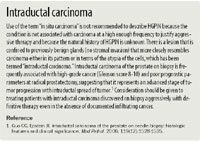Article
PIN or atypical foci suspicious for PCa on biopsy: Risks and recommendations
About 10% of needle biopsy reports will be returned with a diagnosis of prostatic intraepithelial neoplasia (PIN) or of "atypical" cells that are possibly indicative of carcinoma. Armed with knowledge of the likelihood of each of these diagnoses developing into cancer over time, urologists can avoid subjecting patients to unnecessary repeat biopsies.
In approximately 10% of prostate needle biopsy reports, the urologist will get back a diagnosis that is neither benign nor malignant, but rather is classified as either "atypical" or PIN. This report will try to explain these seemingly ambiguous diagnoses.
PIN and its classifications
PIN is classified into low- and high-grade (LGPIN and HGPIN, respectively) lesions.

HGPIN
Because of the evidence suggesting that HGPIN may be a precursor to most or many prostate cancers,1,2 it is important for urologists to be able to correctly identify the condition, to distinguish it from LGPIN and carcinoma, and to be aware of its clinical behavior following discovery upon prostate biopsy.
Incidence and diagnosis. What is important for urologists to remember is that only about 5% of their prostate biopsy reports should contain HGPIN.4 If much lower or higher rates are reported, there is likely a problem with under- or over-reporting of HGPIN by the pathologist. Broader sampling of the prostate might be expected to increase the likelihood of identifying HGPIN on needle biopsy, but this has not been demonstrated to be the case. One study has reported that African-American men have a higher incidence of HGPIN than Caucasian men do.5
There is a marked variation in the incidence of HGPIN on needle biopsy. The most likely explanation for this relates to the vague definition of HGPIN. Although its diagnosis rests on finding prominent nucleoli within cells lining previously benign glands, there are no criteria as to either how prominent the nucleoli must be or, if present, how numerous they must be before a diagnosis of HGPIN is warranted. To some pathologists, a single prominent nucleolus within a prostatic gland might be diagnostic of HGPIN, while to others it might not. How a slide is prepared in terms of the stain, fixative, and sectioning thickness can also impact how easy it is for pathologists to visualize nucleoli and diagnose HGPIN.
There are no special techniques that can be used to distinguish HGPIN from LGPIN. Of cases diagnosed as HGPIN by outside pathologists that were sent to me at the request of either the patient or urologist, 75% were confirmed at our laboratory.6
Newsletter
Stay current with the latest urology news and practice-changing insights — sign up now for the essential updates every urologist needs.
















